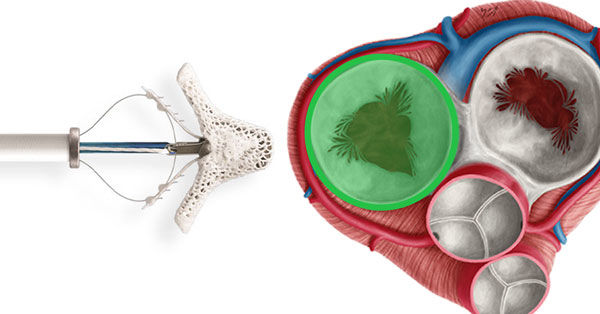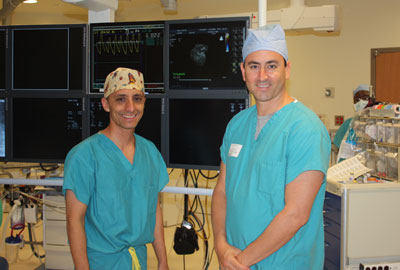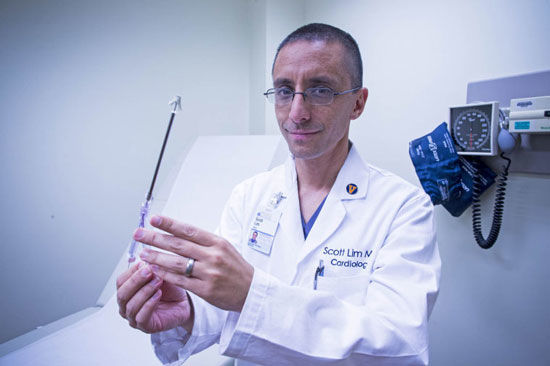MitraClip (Part II): Now For Leaking Tricuspid Valves?
By Adam Pick on September 18, 2017
Big News!!!
In case you missed it, there’s been LOTS of new information flying across the Internet about the use of the minimally invasive MitraClip for… tricuspid valve regurgitation.
That’s right! Let me repeat! The MitraClip, which is typically used as a transcatheter mitral valve repair device, is now being implanted to help patients with leaking tricuspid valves! If you didn’t know, the MitraClip requires no incision to the patient’s sternum or ribs.

I wanted to learn more about this exciting development that caught me completely off-guard. So, I contacted Dr. Scott Lim, who is an interventional cardiologist and MitraClip guru from the University of Virginia Advanced Cardiac Valve Center in Charlottesville, Virginia. As you might recall, I saw Dr. Lim perform a MitraClip case in 2010. Then, Dr. Lim helped us understand the important facts about the MitraClip’s FDA approval in 2013. Most recently, I saw Dr. Lim help save the lives of several heart valve patients in the Dominican Republic during a medical mission. Yes, Dr. Lim is the absolute perfect person to interview about this transformational topic.

1. Is it true that the MitraClip is now being used for patients with tricuspid valve regurgitation?
The MitraClip is a device designed and approved for percutaneous repair of degenerative mitral regurgitation in patients at prohibitive surgical risk. The tricuspid valve is a right sided heart valve, directing the flow of blood from the body, back to the heart. In some cases, that valve fails (tricuspid regurgitation), and starts leaking a significant amount of blood back to the body, and leading to heart failure (retaining fluid, shortness of breath, and fatigue). While surgery to repair or replace the failing tricuspid valve can be performed, in most cases it is not. Surgery may also be considered high risk for an individual patient. In a small number of such cases, cardiologists and surgeons have looked for alternative methods to treat the tricuspid valve – one such alternative method is to use the MitraClip on the regurgitant tricuspid valve.
2. Was the MitraClip designed to treat patients with mitral regurgitation and tricuspid regurgitation?
The MitraClip is inserted from a catheter introduced from the vein in the groin, and routed to the right side of the heart, and placed onto the tricuspid valve. The clip is designed to bring the two mitral valve leaflets together so that they no longer leak blood backwards. It can and has been also used on the regurgitant tricuspid valve leaflets to accomplish the repair of that valve as well. The experience with using the MitraClip, in an off-label indication to repair tricuspid regurgitation, has a very limited experience in a small number of centers around the world.
Here’s a video showing how the MitraClip is positioned in the mitral valve. (I could not find a MitraClip animation for the tricuspid valve just yet.)
3. What is different about using the MitraClip for the tricuspid valve compared to the mitral valve?
Unlike the mitral valve, the tricuspid valve has three leaflets that are more fragile, with a more complex and varied mechanism for leakage. Additionally, the degree of tricuspid regurgitation is intimately associated with the function of the the right ventricle, which remains relatively poorly understood with limited treatment options. Therapies directed at severe tricuspid regurgitation have been less than gratifying when the right ventricular dysfunction has been severe, leading to the presumption that treatment at an earlier stage (less severe degrees of tricuspid regurgitation and right ventricle dysfunction) may have better efficacy.
4. Have you personally used the MitraClip to treat tricuspid regurgitation?
In a number of patients with severe tricuspid regurgitation and who have been judged to be at prohibitive surgical risk, I and my surgical colleagues at the University of Virginia have offered repair of their tricuspid regurgitation with the MitraClip. The advantage of the MitraClip in these very high risk patients is its safety profile, as it is a far less invasive approach than the standard surgical options. We have found that the patients also are able to recover quickly.

5. What’s next for the MitraClip specific to the tricuspid valve?
Going forward, there are a number of clinical trials with novel transcatheter devices designed specifically for the treatment of severe tricuspid regurgitation.
- The MitraClip has been revised and its delivery system redesigned to allow investigating cardiologists and surgeons to use it in percutaneous repair of severe tricuspid regurgitation in the Tri-Illuminate Trial. In this early feasibility study, qualified patients are enrolled in the trial and receive the Tri-Clip (Abbott Vascular, Santa Clara, CA) to repair percutaneously their Tri-Illuminate.
- The SCOUT Trial investigates in an early feasibility study a different approach to severe tricuspid regurgitation. It uses the Tri-Align device (Mitralign, Tewksbury, MA), which uses catheters introduced through a vein to place one or more pairs of pledgeted sutures around the annulus of the tricuspid valve. This then pinches part of the valve together, creating a more competent bileaflet valve out of a previously regurgitant trileaflet valve. The early data from our center and a few others in the United States is quite encouraging, and demonstrates an excellent safety profile. Larger randomized trials are expected.
- The Forma device (Edwards Lifesciences, Irvine, CA) acts to place a spacer within the central portion of the regurgitant tricuspid valve, and is being investigated in a small number of US centers in the trial.
- Lastly, the Cardioband-TR device (Edwards Lifesciences, Irvine, CA) implants an incomplete ring around the regurgitant tricuspid valve, replicating the most commonly used surgical approach, and is anticipated being investigated in a small number of European and US centers in the trial.
As the early experience and these clinical trials are showing us, there is much to learn for cardiologists and surgeons about treating tricuspid valve disease. However, the future is bright for the possibilities of less invasive options for our patients with tricuspid regurgitation.
Many Thanks to Dr. Scott Lim!
On behalf of our community, I would like to extend a mighty thanks to Dr. Scott Lim for helping educate our patient community. Thanks to Dr. Lim, his team at the University of Virginia and Abbott Laboratories, the manufacturer of the MitraClip, the options for treating patients continues to expand. Thanks Scott!!!
Keep on tickin!
Adam










